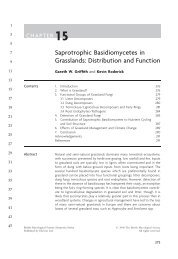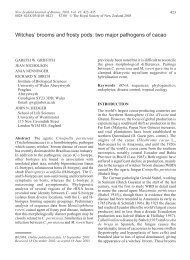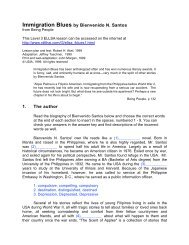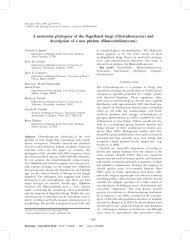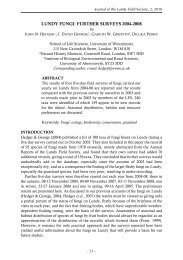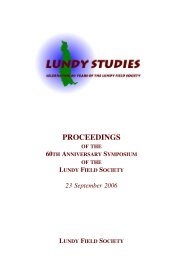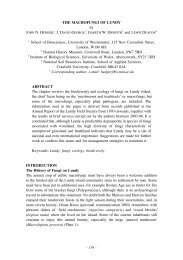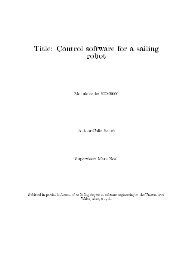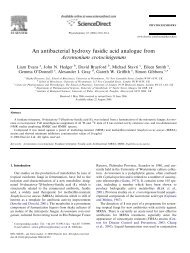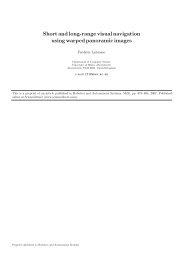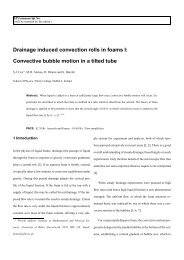Anaerobic rumen fungi
Anaerobic rumen fungi
Anaerobic rumen fungi
Create successful ePaper yourself
Turn your PDF publications into a flip-book with our unique Google optimized e-Paper software.
Agriculturally Important Microorganisms Vol. II<br />
These <strong>fungi</strong> also supply protein to the host through the action of proteolytic enzymes and<br />
also as a proportion of the microbial protein synthesized in the <strong>rumen</strong> that passes to abomasum<br />
and intestines for digestion and absorption (Gordon and Phillips, 1998). Kemp et al. (1985), Gulati<br />
et al. (1989) and Onoda et al. (1993) reported that fungal cells are composed of proteins with a well-<br />
balanced combination of amino acids which were highly accessible to and digestible by the<br />
ruminant; and a high proportion of fungal protein is digested and absorbed in the intestines of<br />
sheep with higher digestibility compared to ruminal bacteria (Gulati et al. 1990). Moreover, the<br />
advent of dependable measurements of fungal biomass in ruminant digesta has shown that in<br />
sheep fed with either hay or grain diets, anaerobic <strong>fungi</strong> averaged 2.4% of the microbial nitrogen<br />
in ruminant digesta (Faichney et al. 1997). However, the contribution of anaerobic <strong>fungi</strong> towards<br />
supply of microbial proteins to the animal was minor as these averaged 1.6% of the microbial<br />
nitrogen in digesta flowing to duodenum. Yet, this microbial protein was of high quality and<br />
voluntarily available to animal. Therefore, if the biomass of anaerobic <strong>fungi</strong> in the <strong>rumen</strong> is<br />
enhanced, it is likely that the supply of high-quality microbial protein to host ruminant would be<br />
possible (Gordon and Phillips, 1998).<br />
13. ISOLATION, CHARACTERIZATION AND PERSISTENCE<br />
To culture the <strong>rumen</strong> anaerobic <strong>fungi</strong>, one of the methods involves overlaying the partially<br />
molten agar with filtered <strong>rumen</strong> fluid and incubation at 39°C (48 hrs) as by this time, zoospores<br />
settle and produce individual thalli to yield pure cultures (Orpin, 1975). Lowe et al. (1985)<br />
suggested a plate culture technique to isolate <strong>rumen</strong> <strong>fungi</strong> from <strong>rumen</strong> digesta of sheep and cattle.<br />
The roll-bottle method of Joblin (1981) involves inoculating a dilution series of molten agar<br />
medium with filtered <strong>rumen</strong> fluid. After a period of incubation, axenic cultures could be obtained<br />
from the individual colonies produced. Antibiotics penicillin, streptomycin, neomycin and<br />
chloramphenicol can be added to the isolation media to suppress bacterial growth (Wubah et al.<br />
1991a). It is difficult to maintain these <strong>fungi</strong> as they require an oxygen-free atmosphere. Hence,<br />
the cultures are to be maintained under CO atmosphere during growth.<br />
2<br />
The paucity of morphological features presents a problem regarding the taxonomy of<br />
anaerobic <strong>fungi</strong>. While examining plant material from the digestive tract, <strong>fungi</strong> often appear as<br />
the complex cluster and this makes the classification even up to genus level difficult. At a time<br />
when there is little disagreement as to the status of the six genera, subgeneric classification is<br />
problematic since difficulties associated with exchange and long-term maintenance of cultures<br />
impeded direct morphological and physiological comparisons among isolates. With the advent of<br />
molecular taxonomy, it is hoped that DNA sequence comparisons and phylogenetic<br />
reconstruction will elucidate the relatedness of the various taxa. Indeed, a number of molecular<br />
phylogenetic papers are on record (Brookman et al. 2000a; Fliegerova et al. 2004; Tuckwell et al.<br />
2 0 0 5 ) , a n d o v e r 1 0 0 n u c l e o t i d e s e q u e n c e s d e p o s i t e d w i t h G e n e b a n k<br />
(http://www.ncbi.nlm.nih.gov).<br />
Majority of the sequences deposited relate to the ribosomal RNA genes widely used in<br />
phylogenetic reconstruction. The small ribosomal (18S) subunit is highly conserved in different<br />
taxa and thus contains little phylogenetically useful information for subgeneric classification (Li<br />
and Heath, 1992). In contrast, the internal transcribed spacer (ITS) regions, widely used for study<br />
of closely related fungal taxa, show a high level of variability (Li and Heath, 1992; Brookman et al.<br />
2000a; Fliegerova et al. 2004), and has been used to differentiate the morphologically similar<br />
monocentric (Neocallimastix, Piromyces) and polycentric (Anaeromyces, Orpinomyces) genera.<br />
Brookman et al. (2000a) also reported that the two multiflagellated taxa (Neocallimastix,<br />
384



